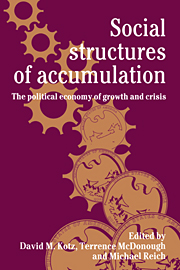Book contents
- Frontmatter
- Contents
- List of contributors
- Introduction
- Part I The theory of social structures of accumulation
- 1 Long swings and stages of capitalism
- 2 How social structures of accumulation decline and are built
- 3 Interpreting the social structure of accumulation theory
- 4 Social structures of accumulation, contingent history, and stages of capitalism
- 5 The regulation theory and the social structure of accumulation approach
- Part II History, institutions, and macroeconomic analysis
- Part III Class, race, and gender
- Part IV The international dimension
- Afterword: New international institutions and renewed world economic expansion
- Comprehensive bibliography on the SSA approach
- Index
1 - Long swings and stages of capitalism
Published online by Cambridge University Press: 08 October 2009
- Frontmatter
- Contents
- List of contributors
- Introduction
- Part I The theory of social structures of accumulation
- 1 Long swings and stages of capitalism
- 2 How social structures of accumulation decline and are built
- 3 Interpreting the social structure of accumulation theory
- 4 Social structures of accumulation, contingent history, and stages of capitalism
- 5 The regulation theory and the social structure of accumulation approach
- Part II History, institutions, and macroeconomic analysis
- Part III Class, race, and gender
- Part IV The international dimension
- Afterword: New international institutions and renewed world economic expansion
- Comprehensive bibliography on the SSA approach
- Index
Summary
Capitalism can be defined as a wage-labour system of commodity production for profit. The owners of the means of production (capitalists) employ immediate producers (workers). Employers pay workers wages, keeping the fruits of the labour process for vending on the market at a profit (or loss).
Given these defining characteristics, several conditions must be satisfied for the existence and reproduction of capitalist economies. The legal system must recognize and protect rights of private property. There must be a substantial supply of wage workers. Capitalists must be able to generate profits in production, requiring reliable and reproducible mechanisms of labor management. At least some basic decisions about production and distribution must be mediated by markets, requiring money as a medium of exchange and a measure of exchange value. Both the household and the state must serve some critical supportive functions, providing steady and continued access to wage labor, shaping the political space within which capitalists can enjoy and command whatever profits they achieve, and contributing to cultural and ideological perceptions that reinforce individualism.
Even if these conditions are met, capitalist economies do not stand still. As the historical materialist perspective suggests, capitalist economies continually change and develop, driven constantly by the dual dynamic forces of intercapitalist competition and capital–labor conflict. The version of the historical materialist perspective that we use illuminates five principal tendencies that have dominated the trajectory of capitalist development.
- Type
- Chapter
- Information
- Social Structures of AccumulationThe Political Economy of Growth and Crisis, pp. 11 - 28Publisher: Cambridge University PressPrint publication year: 1994
- 14
- Cited by

